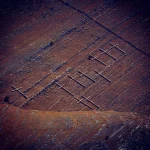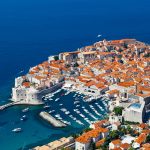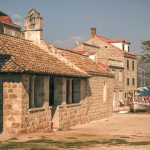August 30, 2019 – The Kornati tragedy occurred on August 30, 2007, when a group of firefighters fell victim to a blaze on the island of Kornati. Of the 13 firefighters in the group, 12 died on the spot or in hospitals, and only one survived – Frane Lučić from Tisno. The event is considered the most terrible disaster since the Croatian War of Independence, with officials dying on duty.
“An unprecedented firefighters´ tragedy happened on the Kornati Islands in Dalmatia, Croatia on August 30, 2007. This is the most terrible disaster since the Croatian War of Independence, with officials dying on duty. The underbrush on the barren, uninhabited side of the island caught fire and firefighters were called to help. As the summer is the season of fires, Croatia had lent a fire-fighting plane to Greece to help fight their fires. So there was an urgent need for another means of transportation and a military helicopter was used to transport firefighters and a water container. The helicopter MI-8 MTV-1 disembarked the water container at one spot, firefighters at another and left. That military helicopter has remained the issue of later speculations. Namely, in “Novi tjednik”, a Dalmatia daily, a shocking article by journalist Jelena Devcic was published entitled “Proofs buried, cleaning fluid on the ground”. It has been speculated that the helicopter hit a rock during maneuvering, and besides a blown tire the tank was damaged with oil and petrol leaking because some oily stains were found on the rocks. The firefighters were soon surrounded by burning underbrush and they burned out.
According to the official expertise that was done later, it was concluded that it was a burn-out of an inhomogeneous gas mixture which occurred by burning vegetation accompanied by strong winds. A similar rare phenomenon was described in Australia in 2003 near Canberra and in Corsica in 2000 near the place Palasca. Besides our leading forensic experts, the leading world firefighting experts were invited to the Republic of Croatia who came to reconstruct the disaster, to find out the dynamics and kinetics of fire, its speed and direction it spreads, height and position of the flame and to assess the freed thermal energy,” reads the official report from Hrvoje Lalić, Professor, Specialist in Occupational and Environmental Medicine at Rijeka Medical School.
Six firefighters from the Šibenik fire department were killed – Dino Klarić, Ivica Crvelin, Ivan Marinović, Marko Stančić, Gabrijel Skočić and Hrvoje Strikoman, and seven more survived with severe burns on the body – five of which were transferred for treatment in Zagreb (Tomislav Crvelin, Ante Crvelin, Josip Lučić, Karlo Ševerdija and Marinko Knežević) who soon died from the consequences of severe burns. The only surviving firefighter, Frane Lučić, was discharged for home treatment after recovering at Split Clinical Hospital.
https://www.youtube.com/watch?v=v=jkg3AUIdkk8
The central celebration of the 12th anniversary of the Kornati tragedy will take place on Friday on the island of Kornati.
“We don’t know the truth, and I don’t think I’ll live to see it, and I doubt anyone will tell it. It is very sad, after 12 years, that no one is responsible for 12 lives, it is very sad,” said Ajka Crvelin, wife and mother of the deceased firefighters, told RTL.
It took ten years for the state to finally settle with Frane Lučić, the only surviving Kornati firefighter. It was decided that the compensation would be 1.75 million kuna, that he would be paid two monthly rents – 1500 kuna for medical preparations and food and 4500 kuna for help and care. He will also be reimbursed for 617 thousand kuna in court costs, all of which, with default interest, will amount to about 5 million kuna as of 2009.
County Fire Commander Dražen Slavica was the only one charged with the Kornati tragedy, the only potential culprit for the death of 12 of his colleague. DORH charged the then fire commander with numerous failures in organizing the intervention, referring minors to the fire, delaying assistance to the victims, etc. At the end of April 2018, he was finally acquitted of all guilt in a repeated trial.
An eruptive fire is an official explanation initially presented to the public as the cause of the accident.
“It has been shown that the temperature at the fire site was over 1200°C and it explained the cause of such a sporadic fire. The cause was the burn-out of an inhomogeneous gas mixture due to the burning of vegetation which was carried by a strong wind that swept over the firemen.
The idea that the kerosene from the army helicopter caught fire was discarded as unfounded and improbable. It was the seasonal receptionist in the Kornati National Park whose cigarette butt started the chain of unfortunate events.
The last question refers to the events after the disaster – why did it take hours to transport the casualties from the island to the mainland, late at night by a naval vessel. Only one fireman survived. Because of the developed PTSD and the undergoing of treatment, he is not able to comprehend the whole event, but he is aware of his colleagues´ death. He was transplanted to Bratislava, Slovakia to have his skin cultivated. He wishes to return to everyday life but has a long rehabilitation before him. In principle, most patients return to work after burn injuries. Of course, it depends on the type and severity of the injury, which often requires a long and intensive hospital therapy as well as other out-hospital treatments. Major burns consequentially lead to the failure of organs, sepsis and shock. The survivors often get damaged muscle-skeletal and circulation systems, but also mental disorders. Deformities, loss of body parts (like the Kornati survivor with a finger handicap), may trigger serious psychological problems. Social support, the role of family and partners is of great importance. It is not only the direct victims that are mentally scarred. Three weeks after the Kornati tragedy, the volunteer fire company secretary hanged himself. He was a high-school teacher and knew the young victims who used to be his students. The captain of the volunteer fire company needed psychiatric treatment,” Hrvoje Lalić continued in the official report.
In September 2009, the government commissioned the Ministries of Culture, Sea, Transport and Infrastructure, Construction and Physical Planning to announce a call for proposals for the conceptual design of the Kornati tragedy memorial, so that it would be completed by the anniversary in 2010. On January 29, 2010, it was announced that the competition for the memorial was won by Zadar architect Nikola Bašić. The plan was to have the design of crosses made up of stones as found on the island, which would fit into the landscape. The memorial crosses on the Kornati islands were completed on May 23, 2010.
Today, we remember Dino Klarić, Ivica Crvelin, Ivan Marinović, Marko Stančić, Gabrijel Skočić, Hrvoje Strikoman, Ante Crvelin, Tomislav Crvelin, Josip Lučić, Karlo Ševerdija, Marinko Knežević and Ante Juričev Mikulin. Twelve lives gone too soon. May they never be forgotten.
You can read more about the Kornati tragedy here.
Excerpts translated from Dalmacija Danas.










